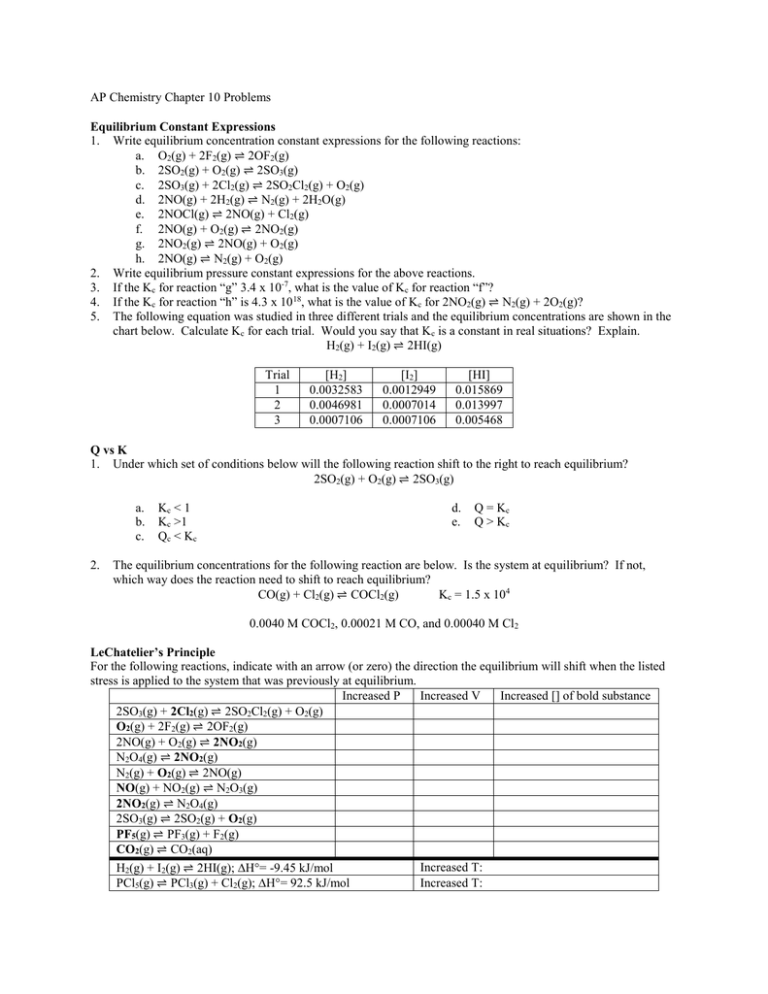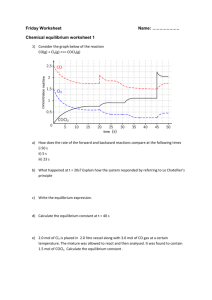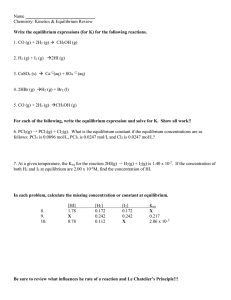AP Chemistry Chapter 10 Problems Equilibrium Constant
advertisement

AP Chemistry Chapter 10 Problems Equilibrium Constant Expressions 1. Write equilibrium concentration constant expressions for the following reactions: a. O2(g) + 2F2(g) ⇌ 2OF2(g) b. 2SO2(g) + O2(g) ⇌ 2SO3(g) c. 2SO3(g) + 2Cl2(g) ⇌ 2SO2Cl2(g) + O2(g) d. 2NO(g) + 2H2(g) ⇌ N2(g) + 2H2O(g) e. 2NOCl(g) ⇌ 2NO(g) + Cl2(g) f. 2NO(g) + O2(g) ⇌ 2NO2(g) g. 2NO2(g) ⇌ 2NO(g) + O2(g) h. 2NO(g) ⇌ N2(g) + O2(g) 2. Write equilibrium pressure constant expressions for the above reactions. 3. If the Kc for reaction “g” 3.4 x 10-7, what is the value of Kc for reaction “f”? 4. If the Kc for reaction “h” is 4.3 x 1018, what is the value of Kc for 2NO2(g) ⇌ N2(g) + 2O2(g)? 5. The following equation was studied in three different trials and the equilibrium concentrations are shown in the chart below. Calculate Kc for each trial. Would you say that Kc is a constant in real situations? Explain. H2(g) + I2(g) ⇌ 2HI(g) Trial 1 2 3 [H2] 0.0032583 0.0046981 0.0007106 [I2] 0.0012949 0.0007014 0.0007106 [HI] 0.015869 0.013997 0.005468 Q vs K 1. Under which set of conditions below will the following reaction shift to the right to reach equilibrium? 2SO2(g) + O2(g) ⇌ 2SO3(g) a. b. c. 2. Kc < 1 Kc >1 Qc < K c d. e. Q = Kc Q > Kc The equilibrium concentrations for the following reaction are below. Is the system at equilibrium? If not, which way does the reaction need to shift to reach equilibrium? CO(g) + Cl2(g) ⇌ COCl2(g) Kc = 1.5 x 104 0.0040 M COCl2, 0.00021 M CO, and 0.00040 M Cl2 LeChatelier’s Principle For the following reactions, indicate with an arrow (or zero) the direction the equilibrium will shift when the listed stress is applied to the system that was previously at equilibrium. Increased P Increased V Increased [] of bold substance 2SO3(g) + 2Cl2(g) ⇌ 2SO2Cl2(g) + O2(g) O2(g) + 2F2(g) ⇌ 2OF2(g) 2NO(g) + O2(g) ⇌ 2NO2(g) N2O4(g) ⇌ 2NO2(g) N2(g) + O2(g) ⇌ 2NO(g) NO(g) + NO2(g) ⇌ N2O3(g) 2NO2(g) ⇌ N2O4(g) 2SO3(g) ⇌ 2SO2(g) + O2(g) PF5(g) ⇌ PF3(g) + F2(g) CO2(g) ⇌ CO2(aq) Increased T: H2(g) + I2(g) ⇌ 2HI(g); ∆H°= -9.45 kJ/mol Increased T: PCl5(g) ⇌ PCl3(g) + Cl2(g); ∆H°= 92.5 kJ/mol Calculations 1. Br2(g) + F2(g) ⇌ 2BrF(g) has Kc= 55.3. What are the equilibrium concentrations of all these gases if the initial concentrations of bromine and fluorine were both 0.250 mol/L? 2. N2O4(g) ⇌ 2NO2(g) has Kc= 5.85 x 10-3. 15.0 grams of N2O4 is confined in a 5.00 L flask at 25°C. a. What is the number of moles of NO2 present at equilibrium? b. What is the percentage of the original N2O4 that is dissociated? c. What is the new value of the equilibrium constant if the volume were increased to 10.0 L? d. What is the new value of the equilibrium constant if the volume were decreased to 2.5 L? 3. A(g) + B(g) ⇌ C(g) + D(g) at 603 K a. At equilibrium a 1.00 L container was found to have 1.60 mols of C, 1.60 mols of D, 0.40 moles of A, and 0.40 mols of B. What is the value of the equilibrium constant? b. What is the value of Kp? c. If 0.20 mol of B and 0.20 mol of C are added to this system, then what will be the new equilibrium concentration of A? 4. PCl5(g) ⇌ PCl3 + Cl2(g) has Kc= 9.3 x 10-2 at 252°C. How many grams of PCl5 must be added to a 2.0 L flask to obtain a Cl2 concentration of 0.15M? 5. H2 + CO2 ⇌ CO + H2O. What is the value of the equilibrium constant if PH2=0.387 atm, PCO2= 0.152 atm, PCO= 0.180 atm, and PH2O= 0.252 atm? 6. Fe2O3(s) + 3H2(g) ⇌ 2Fe(s) + 3H2O(g) has ∆H= 96kJ/mol and Kc= 8.11 at 1000K. a. What percentage of the H2 remains unreacted after the reaction has come to equilibrium? b. Is this percentage going to increase or decrease if the temperature is decreased to below 1000K? 7. What must be true of the value of ∆G° for a reaction if: a. K>>1 b. K=1 c. K<<1 8. CO(g) + Cl2(g) ⇌ COCl2(g). 3.00 mols of Cl2 and 3.00 mols of CO are sealed in a 5.00 L flask at 600°C. At equilibrium 3.3% of the Cl2 has been consumed. a. What is the value of the equilibrium constant? b. What is the value for ∆G° at this temperature? 9. H2(g) + Br2(g) ⇌ 2HBr(g) has Kc= 1.6 x 105 at 1297 K and Kc= 3.5 x 104 at 1495 K. a. Is ∆H° positive or negative? b. Pure HBr is placed into a container at 1297 K. What percentage of the HBr is decomposed at equilibrium?







